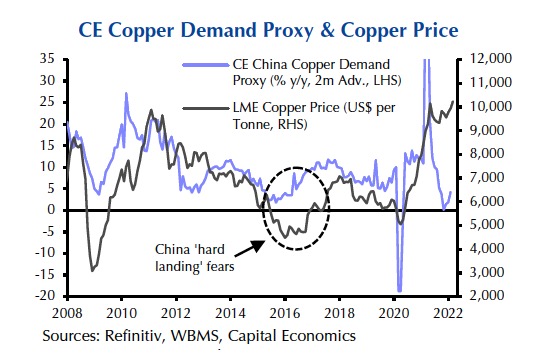GRAPH: Copper price has far to fall as Chinese growth tumbles

The copper price hit an all-time high a week ago as traders looked to stock up on metal amid frantic trading, historically low inventories and fears of escalating supply-chain disruption caused by the Russia-Ukraine war.
When investors sent the bellwether metal to an intra-day high of $5.04 a pound or $11,100 per tonne in New York last Friday amid massive volumes with a nominal value of some $12 billion, concerns over the longer term impact of the Ukraine invasion on global growth, prospects of stagflation in the developed world and a slowing economy in China were clearly set aside.
Copper is now down 8% from the record high with metal for delivery in May trading sideways on Friday on the Comex market in New York, at $4.67 per pound ($10,300 per tonne).
A new report by Capital Economics argues there is weakness ahead amid a gloomier demand backdrop, particularly in China, responsible for more than half the world’s copper consumption.
Yawning gap
The London-headquartered independent researcher has cut its 2022 growth forecasts for China as the country copes with the highest covid numbers since the start of the pandemic (and no indications the country is dropping its zero-covid policy), higher import bills as oil trades above $100 a barrel, damaged exports as Europe and Japan consume less, and higher inflation brought on by a spike in the cost of agricultural commodities.
While Beijing has set a floor of 5.3% GDP growth this year, Capital Economics says it appears to be “bracing for weaker growth in practice” and expects a policy response by officials:
“The NPC [National People’s Congress] pointed to modest easing and suggested that officials would offer more support if unemployment rises much above its current level. But that is unlikely to provide a complete offset.
“We have cut our growth forecast to 2.5%.”
Given copper’s widespread use in industry, construction and transport, the metal’s price correlates with overall economic growth and manufacturing activity and in the world’s largest economy based on purchasing price parity.
A yawning gap has now opened up between the Capital Economics Copper Demand Proxy and the ruling price.

{{ commodity.name }}
{{ post.title }}
{{ post.date }}

Comments